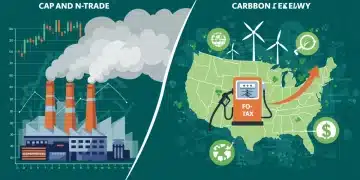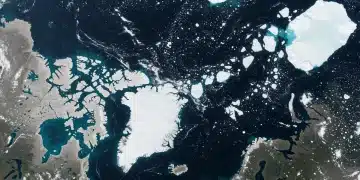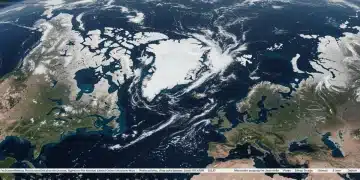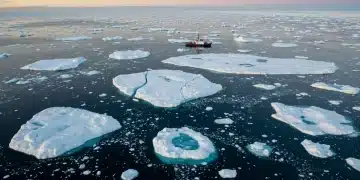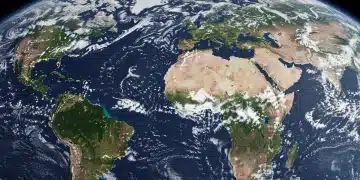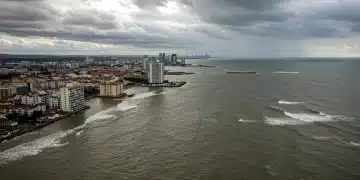Arctic Shipping Routes: 50% Traffic Increase & Environmental Risks by 2025
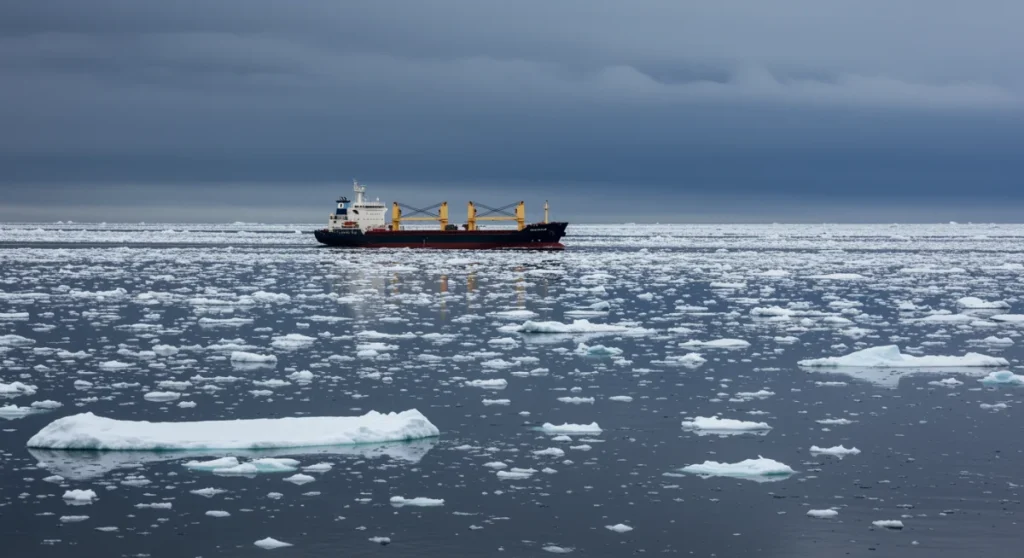
The Arctic is bracing for a projected 50% surge in shipping traffic by 2025, driven by melting ice, posing critical environmental risks to its delicate ecosystems, indigenous communities, and global climate stability.
Arctic Shipping Routes: A 50% Increase in Traffic Expected by 2025 and Its Environmental Risks is quickly becoming one of the most pressing environmental and geopolitical issues of our time. As the planet warms, the once-impenetrable Arctic ice cap recedes, opening new maritime passages that promise shorter, more economical trade routes. However, this burgeoning accessibility comes with a steep price, threatening to unleash unprecedented environmental damage on one of Earth’s most fragile and vital ecosystems.
The Arctic’s rapidly changing landscape and economic allure
The Arctic region is warming at least twice as fast as the global average, a phenomenon that is fundamentally reshaping its geography and accessibility. This dramatic environmental shift is not merely a scientific curiosity; it is a catalyst for profound economic and geopolitical reconfigurations. The melting ice is opening up new shipping lanes, such as the Northern Sea Route (NSR) and the Northwest Passage (NWP), which offer significantly shorter transit times between Asia and Europe compared to traditional routes through the Suez or Panama Canals.
This reduction in travel distance translates directly into lower fuel consumption, decreased operational costs, and faster delivery of goods, making these Arctic routes increasingly attractive to the global shipping industry. The commercial viability of these routes is no longer a distant prospect but a current reality, with a growing number of voyages undertaken each year. This economic incentive is a primary driver behind the anticipated surge in maritime activity, projecting a 50% increase in traffic by 2025.
Key drivers of increased Arctic shipping
- Reduced transit times: Shorter distances between major markets cut down on travel duration.
- Lower fuel costs: Less time at sea means significant savings on fuel, enhancing profitability.
- Growing ice-free periods: Longer seasons of navigable waters make routes more reliable.
- Resource extraction: Access to previously unreachable Arctic resources, such as oil, gas, and minerals, necessitates increased shipping for transport.
The allure of these economic benefits is undeniable, fostering a competitive environment among nations and shipping companies eager to capitalize on these new opportunities. However, the rush to exploit these routes often overshadows the profound environmental implications, creating a complex dilemma between economic gain and ecological preservation.
Environmental risks of escalating Arctic maritime traffic
The projected 50% increase in Arctic shipping risks 2025 brings with it a cascade of environmental dangers that could irrevocably alter the region’s delicate balance. The Arctic ecosystem is highly specialized and extremely vulnerable to external disturbances, making it particularly susceptible to the impacts of increased human activity.
One of the most immediate concerns is the heightened risk of oil spills. Even minor spills can have devastating, long-lasting effects in cold, remote environments where cleanup operations are inherently challenging and often ineffective. The slow degradation of pollutants in icy waters means that contaminants persist for extended periods, bioaccumulating in the food chain and affecting everything from microscopic organisms to apex predators like polar bears and whales. Furthermore, the noise pollution from ships can disrupt marine mammal communication, migration patterns, and foraging behaviors, leading to stress and reduced reproductive success.
Major environmental threats
- Oil spills: Catastrophic potential due to difficult cleanup in icy conditions and slow biodegradation.
- Underwater noise pollution: Disrupts marine mammal communication, migration, and feeding.
- Black carbon emissions: Soot from ship exhausts settles on ice and snow, accelerating melting.
- Introduction of invasive species: Ballast water discharge can introduce non-native organisms, altering local ecosystems.
The cumulative effect of these factors poses a significant threat to the biodiversity and ecological integrity of the Arctic. The region’s unique flora and fauna, many of which are already stressed by climate change, face additional pressures that could push them towards extinction. Protecting this pristine environment requires stringent regulations and a concerted international effort to mitigate these escalating risks.
Impact on indigenous communities and their way of life
For millennia, indigenous communities have thrived in the Arctic, developing profound cultural and spiritual connections to the land and sea. Their traditional lifestyles, deeply intertwined with hunting, fishing, and trapping, are now directly threatened by the surge in maritime traffic and its associated environmental risks. The projected 50% increase in Arctic shipping risks 2025 extends beyond ecological damage, impacting the very fabric of these communities.
Increased shipping activity disrupts traditional hunting grounds and fishing routes, making it harder for communities to access vital food sources. The noise and pollution can scare away marine mammals, which are central to indigenous diets and cultural practices. Furthermore, potential oil spills not only contaminate food sources but also pose risks to the health of those who consume affected wildlife. The economic benefits often touted by proponents of increased shipping rarely reach these communities directly, leaving them to bear the brunt of the environmental and social costs.
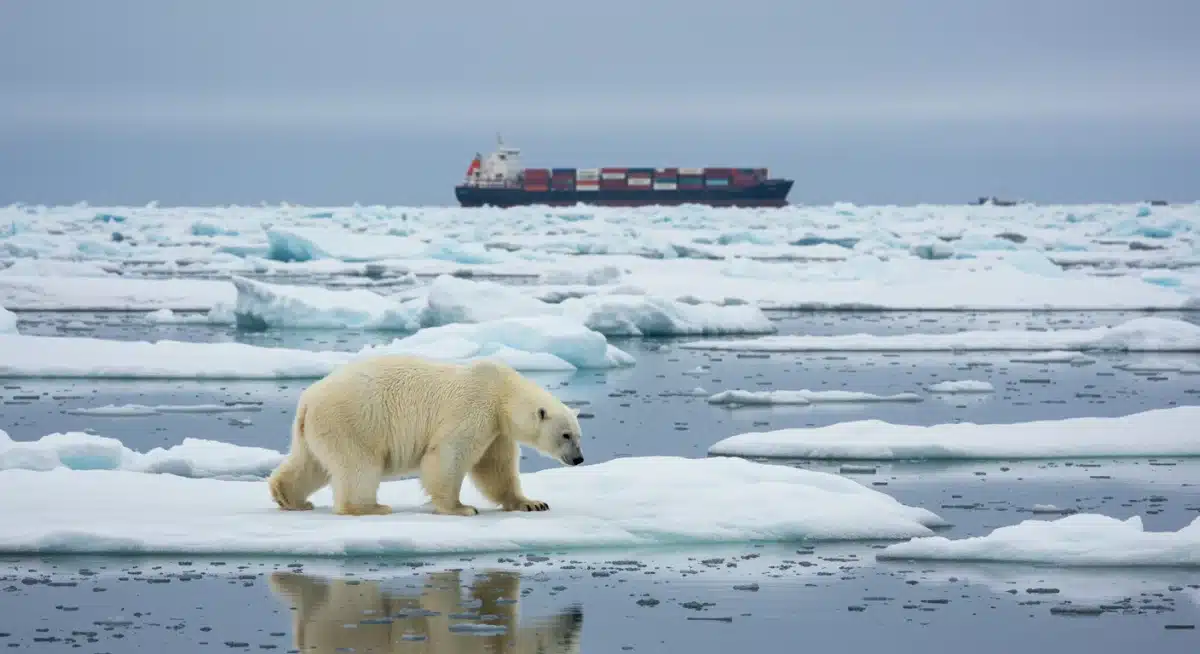
Threats to indigenous livelihoods
- Disruption of traditional hunting and fishing: Changes in wildlife behavior and access to resources.
- Food security concerns: Contamination of traditional foods and reduced availability.
- Cultural erosion: Loss of traditional practices and knowledge due to environmental degradation.
- Increased risk of accidents: Near-misses with large vessels impacting small subsistence boats.
These impacts are not merely economic; they strike at the heart of indigenous identity and cultural heritage. The erosion of their traditional way of life represents an irreparable loss, underscoring the urgent need for their voices to be heard and their rights protected in any discussions concerning Arctic development.
Black carbon and accelerated ice melt
One of the most insidious environmental consequences of increased Arctic shipping is the emission of black carbon. Black carbon, or soot, is a component of particulate matter produced by the incomplete combustion of fossil fuels, particularly heavy fuel oil used by large vessels. When released into the atmosphere, these dark particles eventually settle on ice and snow surfaces. Unlike pristine white ice, which reflects sunlight, black carbon absorbs solar radiation, significantly reducing the albedo effect.
This reduction in reflectivity leads to accelerated melting of glaciers, sea ice, and the Greenland ice sheet. The more ice melts, the more dark ocean water is exposed, which in turn absorbs even more solar energy, creating a dangerous positive feedback loop that further exacerbates global warming. This cycle contributes directly to rising sea levels and further destabilizes the Arctic climate, intensifying the very conditions that make Arctic shipping possible in the first place.
The black carbon feedback loop
- Emissions: Ships release black carbon into the atmosphere.
- Deposition: Black carbon settles on ice and snow.
- Reduced albedo: Dark particles absorb sunlight, decreasing reflectivity.
- Accelerated melting: Ice melts faster, exposing dark ocean.
- Enhanced warming: Dark ocean absorbs more heat, driving further melting.
The impact of black carbon from shipping is particularly potent in the Arctic, where its effects are magnified by the presence of vast ice and snow covers. Addressing this issue requires urgent action, including the adoption of cleaner fuels and propulsion technologies, as well as strict emission regulations for vessels operating in polar waters.
Challenges in regulation and governance
The governance of Arctic shipping routes presents a complex web of international laws, national jurisdictions, and environmental protocols. The anticipated 50% increase in Arctic shipping risks 2025 highlights significant gaps and challenges in the current regulatory framework. While the International Maritime Organization (IMO) has introduced the Polar Code, which sets mandatory safety and environmental provisions for ships operating in polar waters, its enforcement and scope remain subjects of debate.
The vastness and remoteness of the Arctic make monitoring and enforcement incredibly difficult. Issues such as search and rescue capabilities, waste management, and the response to environmental emergencies, particularly oil spills, are severely constrained by the challenging conditions and lack of infrastructure. Furthermore, different nations hold varying interpretations of their sovereign rights and responsibilities in the Arctic, leading to potential conflicts and inconsistencies in regulatory application.
Regulatory hurdles and complexities
- Enforcement gaps: Difficulties in monitoring compliance across vast Arctic expanses.
- Infrastructure deficit: Limited search and rescue, spill response, and waste management facilities.
- Jurisdictional disputes: Overlapping claims and differing national interests in Arctic waters.
- Technological limitations: Current shipping technologies may not be fully adapted to extreme Arctic conditions.
Effective governance requires enhanced international cooperation, robust regulatory frameworks that can adapt to rapid environmental changes, and significant investment in infrastructure and emergency response capabilities. Without these, the risks associated with increased Arctic shipping will continue to escalate unchecked, threatening both the environment and human safety.
Future outlook: Balancing economic opportunity with environmental protection
The trajectory towards a 50% increase in Arctic shipping risks 2025 forces a critical examination of how humanity can balance economic ambition with the imperative of environmental stewardship. The economic benefits of shorter trade routes are substantial, but the long-term costs of environmental degradation could far outweigh any short-term gains, both for the Arctic and for the global climate system.
Moving forward, a multi-faceted approach is essential. This includes accelerating research into cleaner marine fuels and propulsion systems, such as hydrogen or electric power, to reduce emissions. Stricter international regulations, robust monitoring systems, and increased investment in emergency response infrastructure are also paramount. Moreover, integrating the knowledge and perspectives of indigenous communities into policy-making processes is crucial for developing sustainable and equitable solutions.
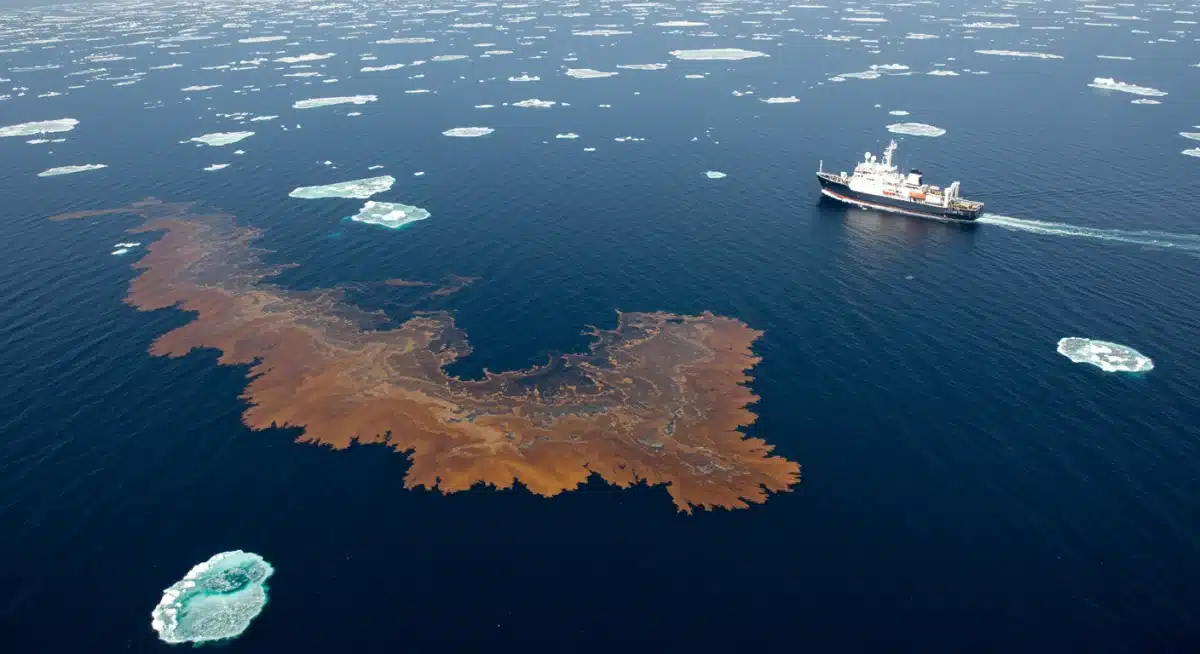
Pathways to a sustainable Arctic future
- Technological innovation: Development and adoption of zero-emission shipping technologies.
- Enhanced international cooperation: Strengthened agreements and joint initiatives for Arctic governance.
- Indigenous knowledge integration: Incorporating traditional ecological knowledge into management plans.
- Investment in infrastructure: Building robust search and rescue, spill response, and port facilities.
The future of the Arctic hinges on a collective commitment to responsible development, recognizing that its health is intrinsically linked to the well-being of the entire planet. The decisions made today regarding Arctic shipping will determine whether this vital region becomes a casualty of climate change or a testament to international cooperation and environmental foresight.
Key Aspect |
Brief Description > |
|---|---|
Traffic Increase |
Arctic shipping traffic expected to rise by 50% by 2025 due to melting ice and economic incentives. |
Environmental Risks |
Includes oil spills, noise pollution, black carbon emissions, and invasive species introduction. |
Indigenous Impact |
Threats to traditional hunting, food security, and cultural heritage of Arctic communities. |
Regulatory Challenges |
Gaps in international law, enforcement difficulties, and infrastructure deficits in remote Arctic. |
Frequently Asked Questions About Arctic Shipping Risks
The primary reason is climate change, which is melting Arctic sea ice, opening up shorter and more economical shipping routes between continents. These routes offer significant savings in fuel and transit time compared to traditional passages, making them highly attractive to the global shipping industry.
Key risks include catastrophic oil spills, increased underwater noise pollution disturbing marine life, emissions of black carbon accelerating ice melt, and the potential introduction of invasive species through ballast water discharge. These threats compound the existing stresses on the fragile Arctic ecosystem.
Black carbon, or soot, from ship exhausts settles on ice and snow, darkening surfaces. This reduces their ability to reflect sunlight, causing them to absorb more heat and melt faster. This creates a dangerous feedback loop, accelerating Arctic warming and contributing to global sea-level rise.
Absolutely. Increased shipping disrupts traditional hunting and fishing grounds, impacting food security and cultural practices. Noise and pollution can drive away marine mammals, vital for subsistence, and oil spills pose direct health risks and contaminate traditional food sources, eroding their way of life.
The IMO’s Polar Code provides mandatory safety and environmental provisions for polar operations. However, challenges remain with enforcement, monitoring, and infrastructure in the vast, remote Arctic. Many experts argue current regulations are insufficient to address the escalating risks of increased traffic effectively.
What this means
The projected surge in Arctic shipping by 2025 is not merely an economic opportunity; it is a critical juncture for environmental policy and international cooperation. The implications extend far beyond the Arctic Circle, affecting global climate patterns, biodiversity, and the rights of indigenous peoples. Monitoring the implementation of the Polar Code, tracking black carbon emissions, and supporting research into sustainable shipping technologies are immediate priorities. The world watches as this pristine, yet vulnerable, region faces unprecedented pressures, underscoring the urgent need for a balanced approach that prioritizes long-term ecological health over short-term economic gains.
